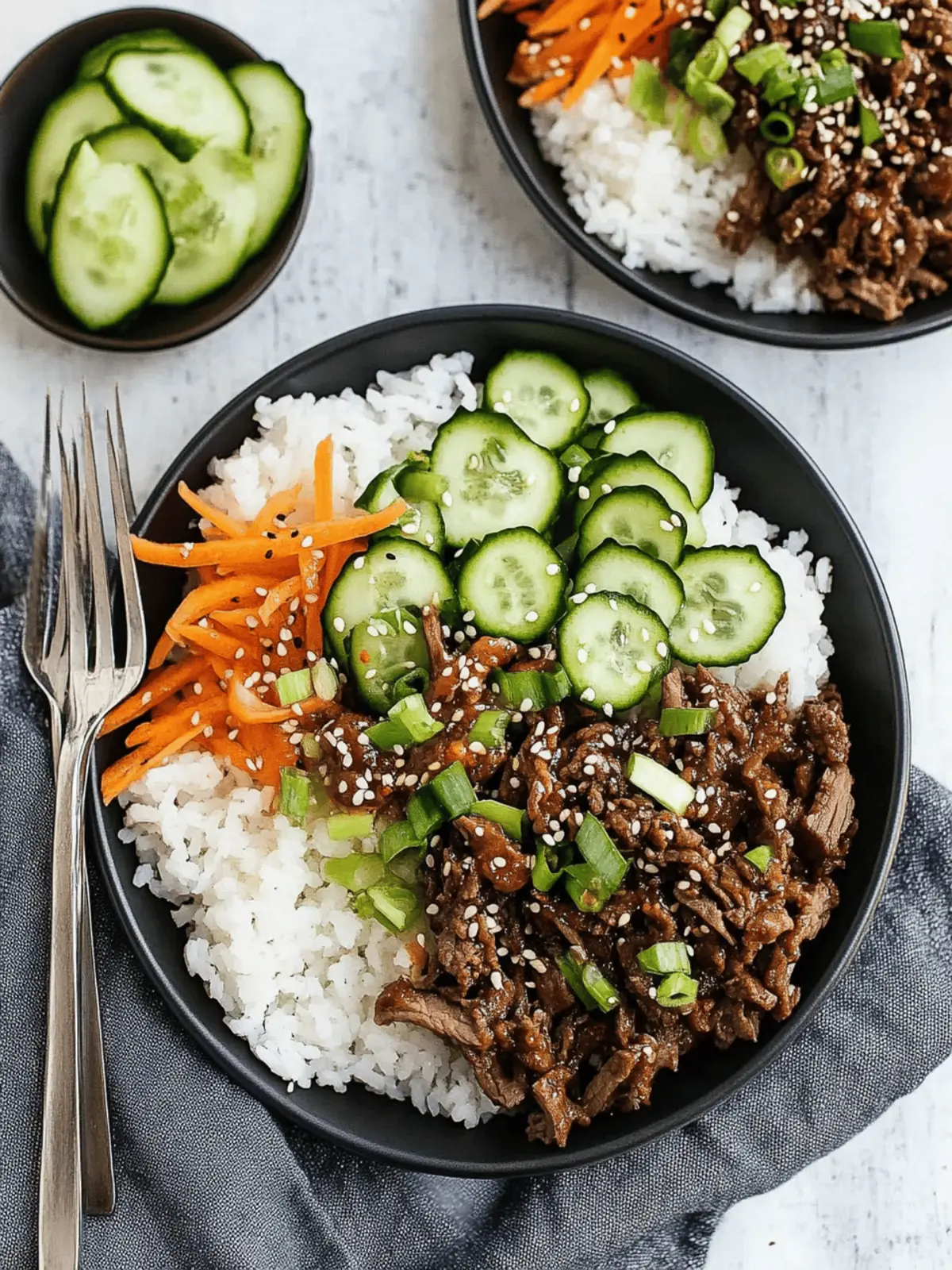After a whirlwind day filled with errands and endless to-do lists, there’s nothing quite like the satisfaction of a quick, home-cooked meal that doesn’t compromise on taste or nutrition. This Quick and Easy Korean Beef Bowl is my go-to solution for those busy evenings when I need something hearty that family and friends will love. Imagine the rich aroma of garlic and ginger mingling in the air as ground beef sizzles in the pan, all while you prepare a seamless blend of fresh veggies and zesty seasonings.
In just 20 minutes, you can whip up a vibrant dish that’s not only packed with bold flavors but also offers the flexibility to adapt to your tastes. Whether you’re serving it over rice or experimenting with quinoa or cauliflower rice, this meal delights and nurtures without the usual hassle. Plus, it’s a fantastic lightened-take on a classic that gives you the best of both worlds comfort food and health in one irresistible bowl. Ready to dive into this culinary adventure? Let’s get cooking!
Why is this Korean Beef Bowl a must-try?
Quick, delicious meal: In just 20 minutes, you can have a satisfying dinner that’s bursting with flavor.
Healthy ingredients: Packed with nutritious veggies and lean ground beef, it fuels you without weighing you down.
Versatile base: Choose from rice, quinoa, or cauliflower rice to fit your dietary preferences.
Easy to customize: Swap out proteins or add your favorite veggies for personal flair.
Crowd-pleasing: Perfect for family dinners or impressing friends during casual get-togethers.
Discover the ease and delight of creating this scrumptious dish in your kitchen!
Korean Beef Bowl Ingredients
• Dive into the essential elements for crafting a mouthwatering Korean Beef Bowl!
For the Beef
• Ground Beef – Provides protein and richness; opt for lean ground beef (like 93% lean) for a healthier option.
• Low Sodium Soy Sauce – Adds umami flavor; substitute with tamari for a gluten-free version.
• Minced Garlic – Enhances aroma and depth of flavor; freshly minced for best results.
• Fresh Ginger (minced or grated) – Introduces warm spice notes; fresh is preferable for a punch of flavor.
• Red Pepper Flakes – Provides heat; adjust the quantity based on your spice tolerance.
• Sesame Oil – Adds nutty flavor; drizzle more for additional taste.
For the Vegetables
• Minced Scallions – Contributes freshness and crunch; use both green and white parts for maximum flavor.
• Shredded Carrots – Adds crunch and sweetness; optional to pickle for an upgraded flavor.
• Seedless Cucumbers – Offers freshness; Persian or English varieties are recommended.
For the Sauce
• Rice Vinegar – Adds acidity to balance the richness of the beef.
• Honey – Offers sweetness to complement salty and savory flavors; adjust to taste based on preference.
For the Base
• Cooked Rice/Quinoa/Cauliflower Rice – Serves as the base; choose according to dietary preferences.
• Toasted Sesame Seeds – Provides a nutty finish when sprinkled on top.
Embrace the flavors and textures of this Korean Beef Bowl with these flavorful ingredients and elevate your home dining experience!
How to Make Korean Beef Bowl
- Brown the Beef: In a large skillet over medium-high heat, add the ground beef. Cook for about 5 minutes, breaking it into small pieces until it’s nicely browned.
- Add Flavors: As the beef cooks, pour in 1 tablespoon of soy sauce and toss in most of the scallions. Keep stirring frequently, allowing those flavors to meld perfectly.
- Incorporate Garlic: Once the beef is fully browned, stir in minced garlic and let it cook for an additional 30 seconds to enhance the aroma.
- Mix the Sauce: In a separate bowl, whisk together rice vinegar, honey, ginger, red pepper flakes, and the remaining soy sauce to create a delicious sauce.
- Combine: Pour the sauce over the beef mixture, stir well, and let it cook for about 2 more minutes to blend the flavors beautifully.
- Finish and Garnish: Take the skillet off the heat and stir in the sesame oil. Garnish with the remaining scallions. Taste and adjust for seasoning as needed.
Optional: Drizzle a bit more sesame oil for extra nuttiness.
Exact quantities are listed in the recipe card below.
Korean Beef Bowl Variations
There’s no limit to how you can personalize your Korean Beef Bowl; let your imagination take the lead!
- Protein Swaps: Use ground turkey, chicken, or pork for a delicious twist on the classic beef. Each option brings its own unique flavor while maintaining that savory depth you crave.
- Veggie Diversity: Toss in bell peppers, snap peas, or bok choy for added crunch and color. Mixed vegetables not only enhance nutritional value but also elevate the overall experience with their vibrant presence.
- Spicy Kick: Introduce gochujang to amp up the heat and bring an authentic Korean touch. It adds a welcomed depth that pairs beautifully with the sweetness of honey and richness of beef.
- Gluten-Free Option: Substitute low sodium soy sauce with tamari or coconut aminos to ensure everyone can savor this dish without worry. The flavor remains rich and satisfying without the gluten!
- Herb Infusion: Sprinkle in fresh cilantro or basil for a refreshing herbal note. These vibrant herbs can awaken the flavors and lend a touch of brightness to your bowl.
- Texture Twist: Consider lightly pickling carrots and cucumbers to elevate their crunch and flavor profiles. A simple vinegar brine adds exciting tanginess that complements the sweetness of your beef wonderfully.
- Sweet and Savory: Swap honey for maple syrup for a unique touch of sweetness. The subtle flavor shift enables a delightful variation that may surprise your taste buds.
- Crispy Topping: Top with fried shallots or crushed chili flakes for an extra crunch and burst of flavor. These additions create a delightful contrast with the tender beef and fresh veggies, adding a new layer of enjoyment.
Explore these variations and transform your Korean Beef Bowl into a reflection of your personal tastes!
What to Serve with Korean Beef Bowl?
Enhance your cozy dining experience with delightful side dishes that complement the bold flavors of this Korean Beef Bowl.
- Sticky Rice: The perfect accompanying base that soaks up the savory sauce, adding a comforting, chewy texture to each bite.
- Lightly Pickled Vegetables: Bright, tangy pickles can cut through the richness of the beef, offering refreshing crunch and brightness.
- Garlic Roasted Broccoli: Tender-crisp broccoli roasted with garlic complements the beef beautifully while adding an earthy depth.
- Sesame Cucumber Salad: A cool, zesty salad with cucumbers and sesame oil brings a refreshing contrast to the hearty dish.
- Kimchi: This traditional Korean side adds a spicy and tangy bite, elevating the flavors and giving an authentic touch.
- Mango Sticky Rice: For a sweet finish, this dessert combines the richness of coconut with the juiciness of mango for a comforting end to your meal.
- Green Tea: A soothing beverage that balances the bold flavors of the beef while offering a calming effect amidst the busy day.
How to Store and Freeze Korean Beef Bowl
Fridge: Store leftovers in an airtight container for up to 4 days. Keep the beef separate from the base for optimal freshness.
Freezer: Freeze portions in airtight containers for up to 3 months. When ready to enjoy, thaw overnight in the fridge before reheating.
Reheating: Warm up the Korean Beef Bowl in a skillet over medium heat for about 5-7 minutes or in the microwave until heated through, stirring occasionally.
Preparation Tips: For best results, reheat only the portion you plan to eat, keeping the fresh vegetables separate until serving.
Make Ahead Options
These Korean Beef Bowls are perfect for meal prep enthusiasts seeking to lighten their busy weeknights! You can prep the beef mixture (cooked and cooled) and store it in an airtight container in the refrigerator for up to 3 days. Additionally, chop your vegetables like cucumbers and carrots a day in advance to keep them crisp. When you’re ready to serve, simply reheat the beef mixture in a skillet over medium heat until warmed through, while you quickly prep your rice or quinoa, ensuring it’s hot and fresh. This method allows you to enjoy a delicious homemade meal that tastes just as great, saving you time while keeping flavors intact!
Expert Tips for the Best Korean Beef Bowl
- Use Lean Beef: Opt for 93% lean ground beef for a healthier Korean Beef Bowl without sacrificing flavor.
- Perfectly Browned: Cook the beef until it’s deeply browned to enhance the dish’s savory profile. Don’t rush this step!
- Customize Your Veggies: Add bell peppers or snap peas for extra crunch. Experiment with veggies based on what you have at home!
- Balance the Sauce: Adjust honey and soy sauce quantities to suit your taste—sweetness can vary based on your preference.
- Top with Freshness: Make sure to garnish with toasted sesame seeds and remaining scallions; they provide delightful texture and flavor!
Korean Beef Bowl Recipe FAQs
How do I choose the right ground beef for my Korean Beef Bowl?
Absolutely! For the best flavor and texture, I recommend using lean ground beef, around 93% lean. This ensures that your dish remains rich but not too greasy. If you’re looking for alternatives, consider ground turkey or chicken for a lighter option. Always check for freshness; the meat should be bright red with no discoloration, and avoid any that has dark spots all over.
How should I store leftovers from the Korean Beef Bowl?
Very! Leftovers can be stored in an airtight container in the refrigerator for up to 4 days. It’s best to keep the beef separate from your grain base (rice, quinoa, or cauliflower rice) to maintain optimal texture and prevent sogginess. When ready to eat, simply reheat it in a skillet or microwave.
Can I freeze the Korean Beef Bowl?
Absolutely! To freeze, divide the Korean Beef Bowl into portions and place them in airtight containers. It will keep well in the freezer for up to 3 months. When you want to enjoy it again, thaw it overnight in the refrigerator. For reheating, warm it in a skillet over medium heat for about 5-7 minutes or microwave it until heated through, stirring occasionally for even heating.
What are some common troubleshooting tips for making this recipe?
If your beef tends to be a bit dry, ensure that you’re not overcooking it. Aim for a nice brown color while keeping it juicy. If you find it too salty, you can temper the flavor with more vegetables or a bit of sugar. Also, adjust red pepper flakes based on your heat tolerance! Start with a small amount and add more if necessary, to avoid overwhelming the dish.
Are there any dietary considerations to keep in mind with this recipe?
Very! This Korean Beef Bowl is naturally gluten-free if you use tamari instead of traditional soy sauce. For allergies, be cautious with sesame oil and seeds as they’re common allergens. Always check labels and choose ingredients that align with your dietary needs. If you’re cooking for someone with allergies or sensitivities, swapping out ingredients is a great way to adapt the dish!
How can I make the vegetables in my Korean Beef Bowl extra delicious?
I often like to pickle the carrots and cucumbers before adding them to the bowl for an extra flavor kick. To do this, simply slice them and soak them in a mixture of equal parts vinegar and water with a pinch of sugar and salt for about 30 minutes. Alternatively, you could sauté some additional vegetables like bok choy or bell peppers in the same skillet for a few minutes before adding your beef for a more integrated flavor.

Savor the Best Korean Beef Bowl in Just 20 Minutes
Ingredients
Equipment
Method
- Brown the Beef: In a large skillet over medium-high heat, add the ground beef. Cook for about 5 minutes, breaking it into small pieces until it’s nicely browned.
- Add Flavors: As the beef cooks, pour in 1 tablespoon of soy sauce and toss in most of the scallions. Keep stirring frequently to meld the flavors.
- Incorporate Garlic: Once the beef is fully browned, stir in minced garlic and let it cook for an additional 30 seconds.
- Mix the Sauce: In a separate bowl, whisk together rice vinegar, honey, ginger, red pepper flakes, and remaining soy sauce.
- Combine: Pour the sauce over the beef mixture, stir well, and let it cook for about 2 more minutes.
- Finish and Garnish: Remove from heat, stir in sesame oil, garnish with remaining scallions, and adjust seasoning as needed.








